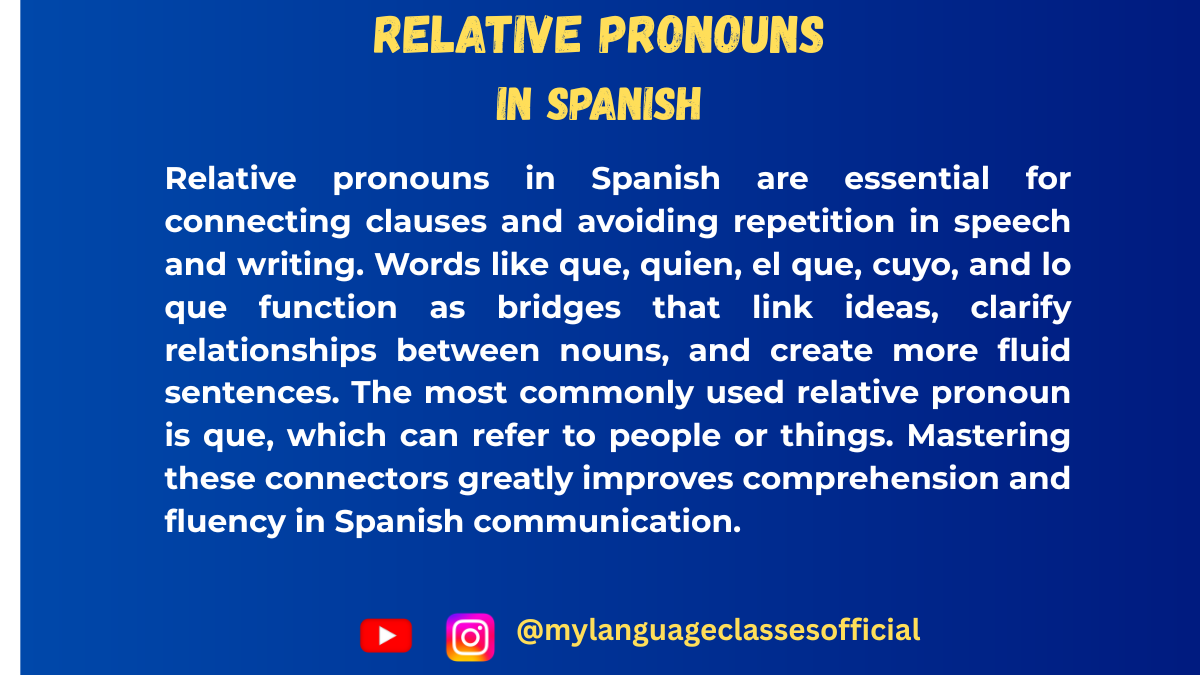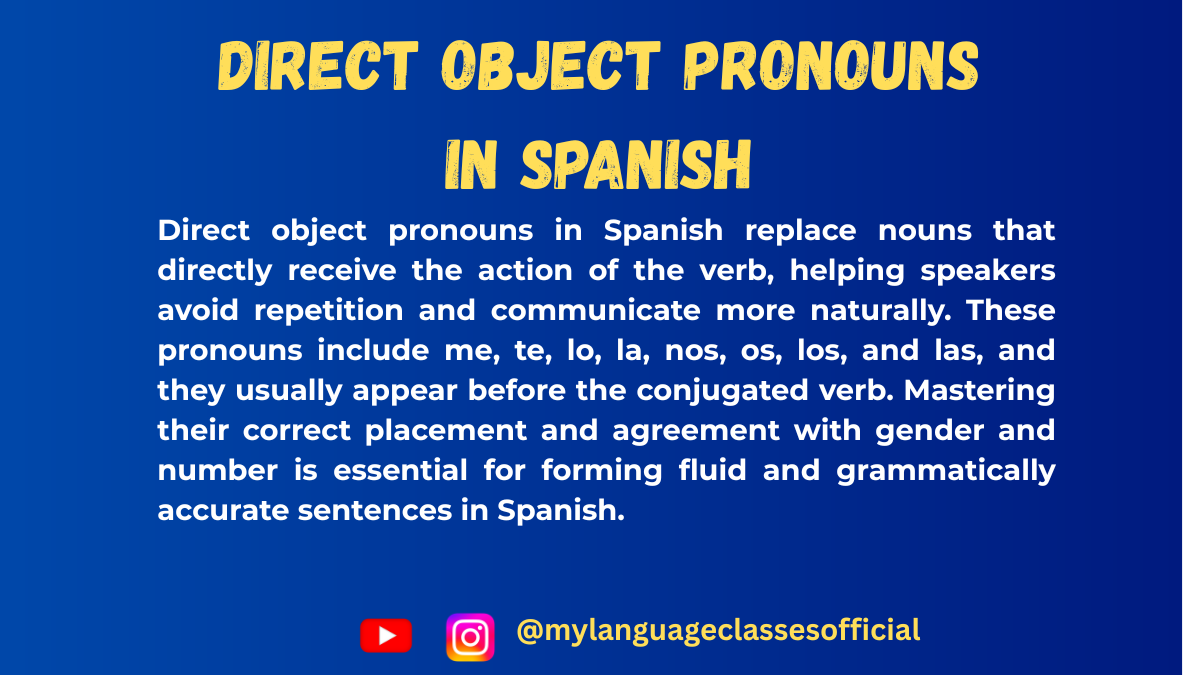Your cart is currently empty!
Tag: Spanish Pronouns Explained
-

Relative Pronouns in Spanish: Que, Quien, Donde, and Others
When learning Spanish, relative pronouns are essential for connecting sentences smoothly and making speech more fluid. These pronouns allow us to refer to people, places, or things without unnecessary repetition. In this blog post, we will explore the different relative pronouns in Spanish, their meanings, and how to use them correctly.
List of Relative Pronouns in Spanish
Relative pronouns in Spanish are used to introduce subordinate clauses and refer to a previously mentioned noun (antecedent). Below is a list of the most common relative pronouns, their meanings, and example sentences:
Relative Pronoun Meaning Example Sentence 1 Example Sentence 2 Que That, which, who La casa que compré es muy grande. La película que vimos fue interesante. Quien / Quienes Who, whom Mi amiga, quien vive en Madrid, me visitó ayer. Los estudiantes, quienes aprobaron, celebraron. Cuyo / Cuya / Cuyos / Cuyas Whose El hombre cuyo coche es rojo está aquí. La chica cuya madre es doctora es mi amiga. Donde Where La ciudad donde nací es hermosa. Este es el restaurante donde cenamos anoche. El que / La que / Los que / Las que The one(s) who/that El libro, el que compraste, es interesante. Las chicas, las que llegaron tarde, son mis amigas. El cual / La cual / Los cuales / Las cuales The one(s) who/that (formal) La casa en la cual crecí está en ruinas. Los estudiantes, los cuales fueron premiados, estaban felices. Lo que What, which No entiendo lo que dijiste. Lo que más me gusta es viajar. Lo cual Which (referring to a whole idea) Perdimos el tren, lo cual fue un problema. Llegó tarde, lo cual nos molestó mucho. Cuanto / Cuanta / Cuantos / Cuantas As much/many as Toma cuanto quieras. Cuantas veces lo intentó, falló. More Example Sentences
- La mujer que trabaja en la tienda es muy amable.
- Mi amigo, quien es muy inteligente, siempre me ayuda.
- El perro cuyo dueño es mi vecino es muy juguetón.
- No entiendo lo que está pasando.
- El país donde nací es hermoso.
- Los estudiantes, los cuales estudian mucho, sacaron buenas notas.
- La casa en la que crecí tiene muchos recuerdos.
- No sé lo que quieres decir.
- Las flores que compraste son muy bonitas.
- La ciudad donde vivo tiene muchas atracciones turísticas.
Things to Keep in Mind
- Agreement in Gender and Number:
- “Cuyo” agrees in gender and number with the noun it modifies: El hombre cuyos hijos estudian aquí…
- “El que, la que, los que, las que” also change according to the noun they refer to.
- Use of Articles:
- “El cual, la cual, los cuales, las cuales” often appear with a preposition and are more formal.
- “Lo que” and “lo cual” refer to entire ideas or situations.
- Que vs. Quien:
- “Que” is used for both people and objects.
- “Quien” is used mainly for people and must match singular or plural (quien/quienes).
- Where to Use Relative Pronouns:
- “Donde” is for places.
- “Lo que” and “lo cual” refer to abstract concepts.
- “Cuyo” means “whose” and agrees with the possessed noun.
Fill in the Blanks
- La chica _______ vive al lado es muy simpática.
- El perro _______ dueño es mi vecino ladra mucho.
- No entiendo _______ dices.
- La ciudad _______ naciste es hermosa.
- Mi amigo, _______ es doctor, trabaja en el hospital.
- Las flores, _______ compraste ayer, están muy bonitas.
- Juan, _______ hermano es mi compañero, me ayudó con la tarea.
- La razón por _______ llegamos tarde fue el tráfico.
- No sabía _______ querías decir.
- El edificio _______ ventanas son grandes es nuevo.
Answers
- que
- cuyo
- lo que
- donde
- quien
- las que
- cuyo
- la cual
- lo que
- cuyas
Conclusion
Mastering relative pronouns in Spanish is essential for improving fluency and making speech more natural. Understanding the gender, number agreement, and context in which each pronoun is used will help you construct sentences more accurately. Keep practicing with different sentence structures, and soon, using these pronouns will become second nature.
If you enjoyed this lesson, be sure to check out more posts like this on my blog at My Language Classes. Don’t forget to subscribe my YouTube channel and follow me on Instagram for the latest language learning tips and lessons. Leave a comment below to share your thoughts, or ask any questions you have.
Happy learning! 😊
-

Mastering Direct Object Pronouns in Spanish
When learning Spanish, one of the most essential skills is understanding how to use direct object pronouns. These little words can simplify your sentences and make your speech sound more fluid and natural. In this blog, we’ll explore what direct object pronouns are, how they’re used, and provide plenty of examples to help you master them.
What Are Direct Object Pronouns?
A direct object in a sentence answers the questions “what?” or “whom?” about the verb. For example:
- I see the book. (What do I see? The book.)
- She calls her friend. (Whom does she call? Her friend.)
In Spanish, instead of repeating the noun (like “the book” or “her friend”), we replace it with a direct object pronoun.
The Direct Object Pronouns in Spanish
Here’s a handy table of direct object pronouns:
Pronoun English Meaning Me Me Te You (informal) Lo Him/It (masculine) La Her/It (feminine) Nos Us Os You all (informal, Spain) Los Them (masculine/mixed) Las Them (feminine)
Placement of Direct Object Pronouns
In Spanish, the placement of direct object pronouns can seem tricky at first, but there are clear rules:
- Before a Conjugated Verb
- Example:
- Yo veo el carro. (I see the car.) → Yo lo veo. (I see it.)
- Ella compra las flores. (She buys the flowers.) → Ella las compra. (She buys them.)
- Example:
- Attached to an Infinitive
- Example:
- Voy a llamar a María. (I am going to call María.) → Voy a llamarla. (I am going to call her.)
- Example:
- Attached to a Present Participle
- Example:
- Estoy leyendo el libro. (I am reading the book.) → Estoy leyéndolo. (I am reading it.)
- Note: Add an accent to maintain proper stress when attaching the pronoun.
- Example:
- Attached to an Affirmative Command
- Example:
- Compra el pan. (Buy the bread.) → Cómpralo. (Buy it.)
- Note: Add an accent when necessary to preserve the original stress.
- Example:
Examples in Action
Here are some real-life scenarios where direct object pronouns are used:
Simple Sentences
- ¿Tienes el dinero? (Do you have the money?)
→ Sí, lo tengo. (Yes, I have it.) - ¿Conoces a Ana? (Do you know Ana?)
→ Sí, la conozco. (Yes, I know her.)
Questions and Negatives
- ¿Estás mirando la televisión? (Are you watching the TV?)
→ No, no la estoy mirando. (No, I’m not watching it.)
Infinitives
- ¿Vas a ver la película? (Are you going to watch the movie?)
→ Sí, voy a verla. (Yes, I’m going to watch it.)
Commands
- Escribe la carta. (Write the letter.)
→ Escríbela. (Write it.)
Common Errors to Avoid
- Confusing Direct and Indirect Object Pronouns
Remember, direct object pronouns answer “what?” or “whom?”, while indirect object pronouns answer “to whom?” or “for whom?”Example:- Direct: Lo veo. (I see him.)
- Indirect: Le hablo. (I speak to him.)
- Forgetting to Match Gender and Number
Make sure the pronoun matches the noun in gender and number. For example:- Las cartas (the letters) → las
- El carro (the car) → lo
- Misplacing Pronouns
Incorrect: Voy llamarla.
Correct: Voy a llamarla or La voy a llamar.
Practice Time!
Let’s put your skills to the test. Try replacing the direct object with a pronoun in the following sentences:
- Yo compro las manzanas.
- Nosotros vemos a Juan.
- María está leyendo el libro.
- ¿Has visto a tus amigos?
- Compra los billetes.
Answers
- Yo las compro.
- Nosotros lo vemos.
- María está leyéndolo.
- ¿Los has visto?
- Cómpralos.
Final Thoughts
Direct object pronouns are a powerful tool to make your Spanish more efficient and natural. With practice, using them will become second nature. Start incorporating them into your conversations today—you’ve got this!
Keep practicing, and soon you’ll sound like a native! 😊
If you enjoyed this lesson, be sure to check out more posts like this on my blog at My Language Classes. Don’t forget to subscribe my YouTube channel and follow me on Instagram for the latest language learning tips and lessons. Leave a comment below to share your thoughts, or ask any questions you have.
Happy learning! 😊
